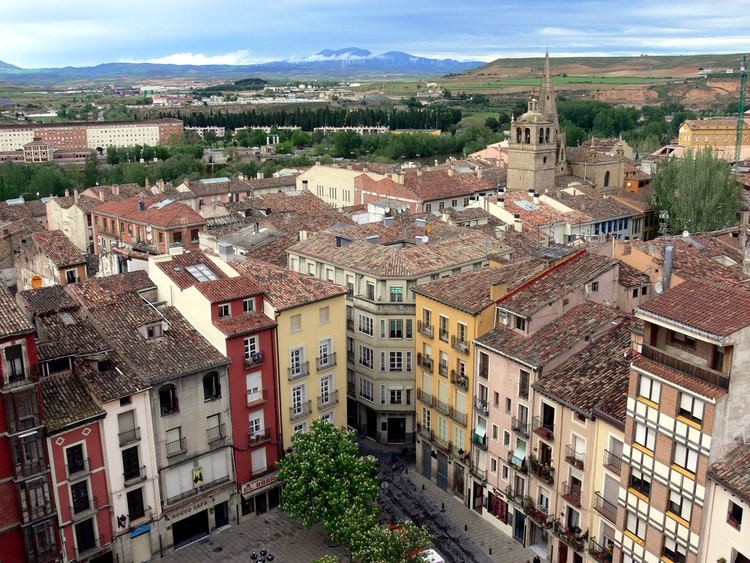Country Province La Rioja Area 79.57 km2 | Population 153,402 (2012) Mayor Concepcion Gamarra (PP) | |
 | ||
University University of La Rioja | ||
Logroño ([loˈɣɾoɲo]) is a city in northern Spain, on the Ebro River. It is the capital of the province of La Rioja.
Contents
- Map of Logroo
- A little walk through logrono spain 2017
- Geography
- Climate
- History
- Economy
- Food
- Places of interest
- Recreation plazas and parks
- Social life
- Broadcasting stations
- Sports
- Festivals and traditions
- Twin townssister cities
- Transport
- In popular culture
- Calle laurel de logro o la rioja spain
- References
Map of Logroño
The population of the city in 2008 was 153,736 while the metropolitan area included nearly 197,000 inhabitants. The city is a centre of the trade in Rioja wine, for which the area is noted, and produces wood, metal and textile products.
A little walk through logrono spain 2017
Geography
Logroño is located in the northern region of La Rioja, on the river Ebro, 384 metres (1,260 feet) above sea level. The Camino de Santiago passes through the city. The geographical coordinates of the city are: 42° 27′ N, 2° 29′ W.
The city lies 152 km (94 mi) from Bilbao, 172 km (107 mi) from Zaragoza, 336 km (209 mi) from Madrid and 468 km (291 mi) from Barcelona.
Climate
The weather in Logroño —mostly due to its peculiar location, both in terms of distance to the Atlantic coast and in the situation along the course of the Ebro river, is characterized by values ranging from those typically found in temperate oceanic climates to the warmer and drier ones observed in southeastern mediterranean regions of the river's valley. The average annual temperature is 13.9 °C (57 °F). Although much infrequent, unusually low temperatures during the winter can drop to −5 °C (23 °F), and as low as −10 °C (14 °F); while daily high averages may exceptionally exceed the mark of 35 °C (95 °F) in a particularly hot summer. The average annual precipitation is about 400 mm (15.75 in), regularly spread over the whole year: from 20 mm (0.79 in)–25 mm (0.98 in) in drier periods to the 45 mm (1.77 in)-50 mm (1.97 in) range in the rainiest.
History
Logroño was an old settlement, first of the Romans, under the name of Vareia, a commercial port, and then of the Celts‹See TfD›. From the 10th century, possession of Logroño was disputed between the kings of Navarre and those of Castile; the region was finally annexed to Castile. The name is a combination of le and Groin, mashed together as Logroño over time. Alfonso VI of Castile granted Logroño in 1095 a charter of rights that served as a model for other Spanish cities. In 1609 and 1610 Logroño was the main seat of the Basque witch trials, part of the Spanish Inquisition.
Famous people from Logroño include Manuel Bretón de los Herreros, Fausto Elhúyar, Práxedes Mateo Sagasta, Rafael Azcona, Ramón Castroviejo, Pedro J. Ramírez, Navarrete "El Mudo".
Economy
Logroño is the shopping and financial capital of La Rioja. Its economy is heavily reliant on wine. It is twinned with Dunfermline, Darmstadt, Libourne, Dax, Rancagua, Ciudad de La Rioja, Brescia, Hagunia. The new airport Logroño-Agoncillo connects the city with Madrid and Barcelona.
Food
There are over 50 taperías (tapas restaurants) located within a four-block area near the town center. The traditional tapas restaurants often serve only one tapa [such as seta (mushroom), served as pincho - pintxo in Basque - meaning one serving, or media ración ("half portion"), a small plate of tapas], but offer the Rioja D.O..
Places of interest
Recreation (plazas and parks)
Social life
Calle del Laurel, known as "the path of the elephants" and Calle San Juan are typical streets where various restaurants and tapas bars offer some of the best pinchos and tapas in northern Spain. Calle Portales is the main street in the old town, where people like to walk and sit in the terraces to eat a meal or drink wine. Calle Marqués de San Nicolás (otherwise known as Calle Mayor) is the main area where people spend weekend nights.
Broadcasting stations
Southwest of Logroño, at 42°26'34"N 2°30'43"W, there is a mediumwave broadcasting station with a transmission power of 20 kW. There may exist a longwave transmitter with 300 metres tall masts at Logroño with 300 metres tall masts transmitting RNE Todo Noticias on 207 kHz.
Sports
Triple jumper Carlota Castrejana is from the city. David Lopez Moreno, the Brighton & Hove Albion midfielder is from Logroño.
Festivals and traditions
The patron saint of Logroño is Santa María de la Esperanza.
The most important festivals are:
During the first week of January there is a cultural festival known as "ACTUAL" with music, theater and art.
Twin towns—sister cities
Logroño is twinned with:
Logroño is associated with:
Transport
The city is served by the new Logroño railway station.
In popular culture
In the 4th season of the HBO television series True Blood, the witch Antonia is from Logroño. She refers to herself as Antonia Gavilan de Logroño.
